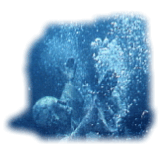|
Continuing my series of old and forgotten but potentially significant disappearances in the Triangle, let’s touch on the disappearance of Cuban revolutionary hero Camilio Cienfuegos. Due to the political nature of Castro’s volatile revolution and new administration, early authors on the Bermuda Triangle avoided mentioning Cienfuegos’ disappearance as applicable to the Bermuda Triangle. Charles Berlitz (The Bermuda Triangle, 1974) only in general glanced off the concept that political elements could have been involved in types of disappearances. “While certain abandoned small boats found on the high seas after the Cuban revolution may have had something to do with the activities of escaping Cubans and those pursuing them . . .” he too avoided the very publicized disappearance of Cienfuegos in a Cessna 310 in 1959.
Contemporarily, no one was sure (in America or Cuba) whether Cienfuegos intentionally disappeared or whether his was an engineered death. But time allows us to look more 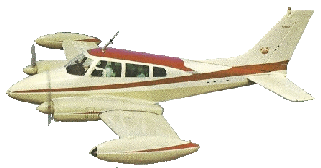 objectively at the case of the very famous disappearance of a revolutionary icon. objectively at the case of the very famous disappearance of a revolutionary icon.
A number of the Cuban military leaders under Fidel Castro were dashing Spaniards, but none matched Camilio Cienfuegos. He was a bon vivant with a distinctive Biblical beard, and despite the tangled sage Cienfuegos was a captivating and convivial man. He had joined Fidel Castro’s July 26 Revolutionary Movement in Mexico. To begin the revolution, a small band (82) of Cuban guerillas journeyed to Cuba on the yacht Granma and landed on December 2, 1956. Of these men, only 11 (other sources say 17) survived to become the germinal influence for the the revolution. Cienfuegos was one of them.
As the revolution had grown and advanced across the island, Cienfuegos had become instrumental in leading battles and organizing campaigns. He had also become famous. Handsome, dark penetrating Latin eyes, raven hair combed back, an almost benevolent, thoughtful look, he captivated Cubans. He also sported a jaunty cowboy hat, a bit of a cavalier contrast to the olive green of his drab military fatigues. By the time Fidel Castro’s 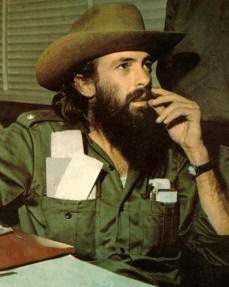 forces stood at the gates of Havana, Cienfuegos had risen to command the forces that eventually seized the capital. forces stood at the gates of Havana, Cienfuegos had risen to command the forces that eventually seized the capital.
His fame went beyond the jungle guerilla battlefields. He was carefree and enjoyed the nightlife of Havana when it was still the crown jewel of the Caribbean. He was only 27 and adored by the people. He was distinctive in his cowboy hat, cigar, and gleeful smile.
Part of Cienfuegos’ charm was that he wasn’t a political ideologue. He was viewed as purely a revolutionary against tyranny. No one knew if he was a communist, socialist, or whatever. He did not express political views. It was known that he was the son of anarchists who had moved from Spain to Cuba, where he had been born. In political power, he had shown himself liberal. He was, as he said, a believer in Cubanisima!— those quintessential things that define and reflect Cuba. The most likely reason he was so popular is that he was a romantic revolutionary against authority rather than any political idealist.
Another factor for his fame was the era itself. It was the epoch of rebellion for the sake of it. “What’d you got?” replies Marlon Brando’s character in the The Wild One, in response to being asked what he’s rebelling against. It was the era of Rebel Without A Cause, and images of Che Guevara and Camilio Cienfuegos struck this chord throughout American youth and the world, especially Guevara’s (as he lived on) image, representing rebellion for the sake of rebellion.
There is enough on the life and revolutionary accomplishments of Camilio 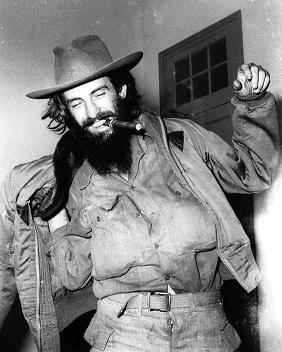 Cienfuegos for the reader to consult. The Spanish language sites online would be preferable. There is no need to repeat it here. I am interested only in the events leading to his final flight. Cienfuegos for the reader to consult. The Spanish language sites online would be preferable. There is no need to repeat it here. I am interested only in the events leading to his final flight.
Camilio Cienfuegos, as often seen— jovial, cigar, cowboy hat, paternal to his men. He refused to torture and massacre. He would even wait to eat until prisoners had eaten. He was “Lord of the Vanguard,” leading the Caravan of Freedom to triumph in Havana. Camilio Franqui called him a “rumbero Christ” because of his smile and beard.
After their victory, Castro named Cienfuegos Chief of Staff. This was a powerful position and he held extensive military command.
As in all other revolutions, there was a period of flux after victory. To many loyal members of the revolution, it appeared that Castro was consolidating power and betraying the revolution. There was worry about the rise of competing parties due to Cienfuegos’ liberal approach to reform. (He allowed all parties to flourish so long as they were not dependent on a foreign power). The United States was viewed as a potential threat, since the revolutionaries had regarded the deposed dictator Batista as an American stooge. Castro wanted to move closer to the Soviet Union as a safeguard (supposedly), and this meant outright communism.
Cuba had been the jewel of the Caribbean, with Havana the golden crown. Cruise ships came from all over the world. Sugarcane was a massive and profitable export. The revolution had been about getting rid of the corrupt Batista, not installing communism. Many were growing concerned.
One of those was Huber Matos, the military governor of Camagüey. He openly objected when Castro replaced Cienfuegos as Chief of Staff with his own brother Raul Castro. Fidel condemned Matos as a traitor, and in early October he ordered Cienfuegos to go arrest him. Many disagreed with Castro turning on Matos with such vigor and counseled him this was a mistake. It is said Camilio Cienfuegos refused to arrest Matos until ordered personally. He flew to Camagüey and treated Matos well. He wouldn’t handcuff him and walked alongside him before the press and troops. Matos was sent to Havana and Cienfuegos stayed behind to reorganize Matos’ military forces, 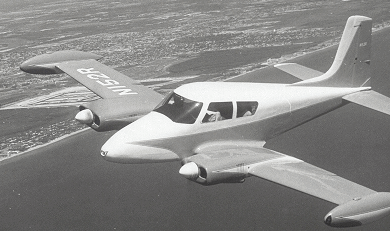 many of whom had been loyal to Matos and his views. many of whom had been loyal to Matos and his views.
A Cessna 310— a puddle jumper with 2 light engines.
On October 28, 1959, Cienfuegos left Camagüey in a small twin engine Cessna 310, in order to return to Havana. He had aboard pilot and an assistant. The plane vanished. This was news indeed. But no one knew where it vanished. Aircraft overflights could find no wreckage in a Cuban field or jungle. Reports then came that a small plane resembling the Cessna 310 was thought to have fallen into the sea north of Isabela de Sagua. A fleet of boats led by Fidel himself went and searched.
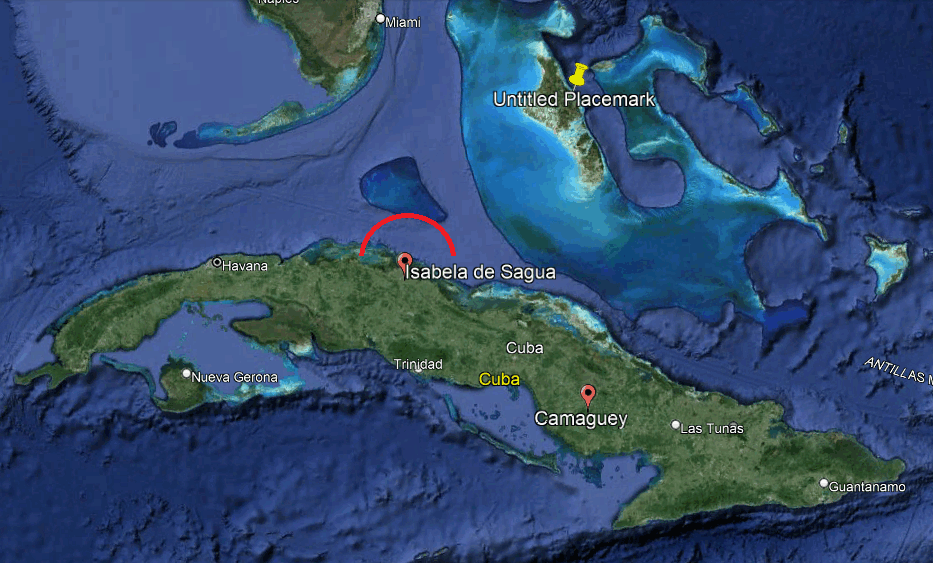
The arch shows the search area (by boat) off Isabela de Sagua). Following the coast to Havana at this point is hard to explain, as it would be faster to maintain a straight line just within the coastline.
Florida newspapers followed the events closely, especially after the report from a freighter in the Florida Strait that a Cessna matching the model type of a 310 was seen overhead flying north. It was now speculated that Cienfuegos was defecting from Cuba and coming to Florida.
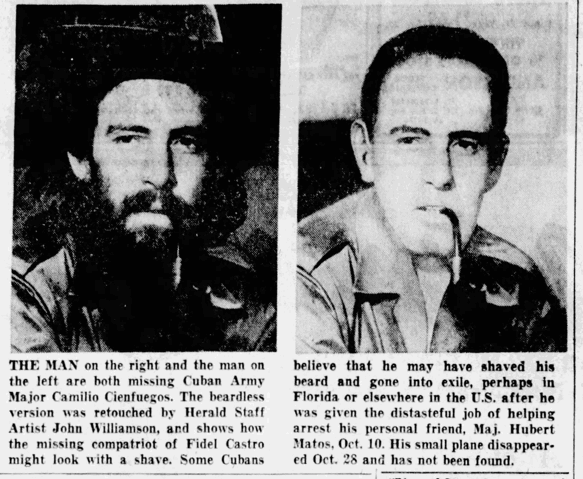
This Miami Herald piece speaks for itself.
Due to successive revolutions in Cuban over the previous decades, Miami and Ybor City (near Tampa) always had a strong Cuban colony. Nevertheless, it seemed Cienfuegos hadn’t landed in America. November 8, the Miami Herald reported 34 Air Force and Civil Air Patrol planes were overflying the Everglades attempting to spot Cienfuegos’ plane, the premise being it may have crashed in the swamps. Nothing was spotted, of course. The search had been as far north as Sarasota and as far west as the Marqueses keys.
The search was eventually halted. The popular hero Cienfuegos, only 27 years old, was declared to have died in a air crash . . . somewhere.
I will only touch briefly on a few points conspiracy theories bring up, but I will put a different angle on them. One, it was said that the pilot of the Cessna 310 was “inexperienced.” This is irrelevant to conspiracy, as it presupposes he will crash and leave no trace. However, this may explain why the aircraft was suspected to have flown along the northern coast. The pilot may not have been a very good navigator. He thus flew to the coast in order to follow it to Havana.
The idea that the Castros planned “the bearded one’s” disappearance is stupid. The disappearance of celebrities like Amelia Earhart or Glenn Miller tell anybody what the result is— immortality. To die puts an end to things; to disappear is to forever remain alive but in limbo, as indeed Cienfuegos’ memory has done. Moreover, Cienfuegos was in charge of reorganizing the military in the large province, one that had many disgruntled anti-Castro officers in it. Fidel Castro never would have sent him there if he didn’t trust him completely. It doesn’t sound like Cienfuegos was regarded as a threat.
Sabotage must be taken seriously. Cienfuegos was in Camagüey for about 20 days. This is plenty of time for those loyal to Matos, and increasingly growing anti-Castro, to seek revenge for Cienfuegos arresting him.
The true fact is: no one knows where the Cessna 310 was flying. It could have come down into a Cuban jungle. It could have come down north of Cuba in the Triangle for reasons unknown. This too is why Cienfuegos disappearance didn’t eventually enter the litany of Bermuda Triangle victims. Yes, the area is the Bermuda Triangle, but really where was he flying?
The disappearance of Camilio Cienfuegos draws our attention to a significant benchmark in the history of the Bermuda Triangle and thus to our understanding of the phenomenon. Any attempt to unravel the mystery must acknowledge a single fact: the Bahamas stand separate and distinct from all other parts of the geographic Triangle; in retrospect the Cuban revolution amplifies this fact.
National Transportation Safety Board records (through the old Civil Aeronautic Board) go back in Brief form to 1962, but before that one is not on stable ground for assessing the actual number and circumstances of aircraft disappearances. For years I have laboriously tried to uncover as many as possible to at least gauge an average over the decade. Newspapers are not always trustworthy on details, and often they don’t report all the cases. But I have been able to assemble enough cases to underscore a truth—
Aircraft disappearance increased dramatically in the 1960s and maintained the surprising average through the 1990s. One factor immediately presents itself: the Cuban revolution required the rerouting of all aircraft travel going to and from the palmy Caribbean to North America. Instead of being what it once was— a vacation destination— the Bahamas now lay under a torrential skyway.
A mathematic probability applies now to accidents— more planes, higher probability of accident— but what mathematic probability applies to disappearance?
For a short time the Bahamas merited attention as a unique area within the Triangle. The increased number of disappearances in the 1960s was contemporary with the new TV show The Twilight Zone. Aside from disappearances, surreal experiences were being had in the archipelago. It is time again to look at the Bahamas Twilight Zone.
|

